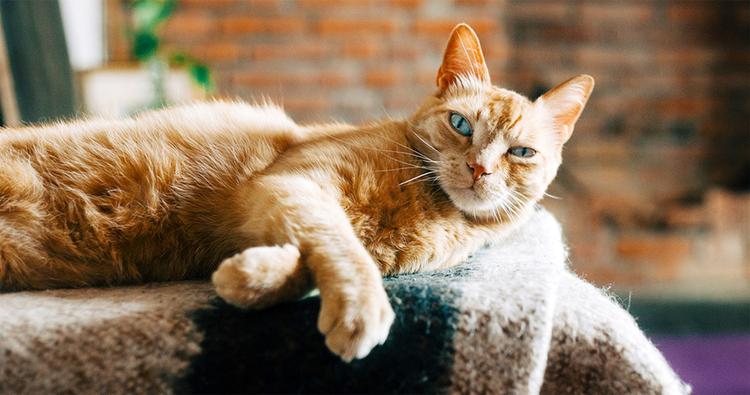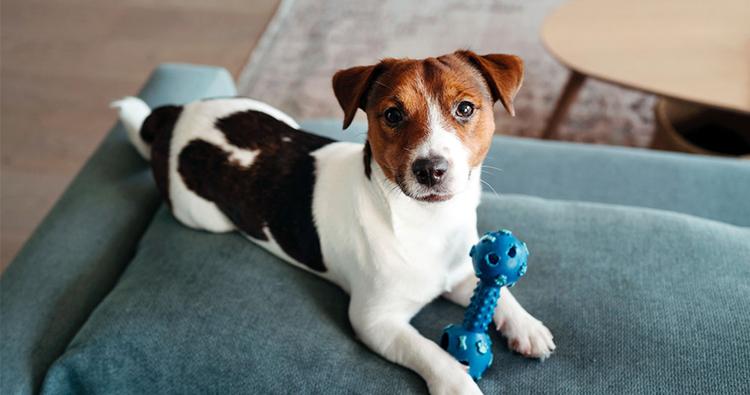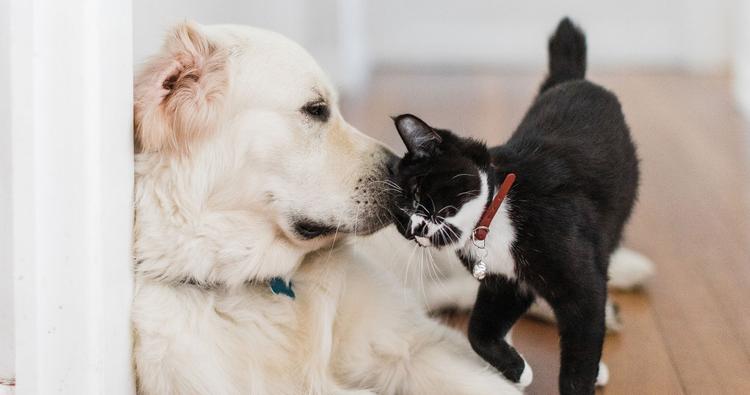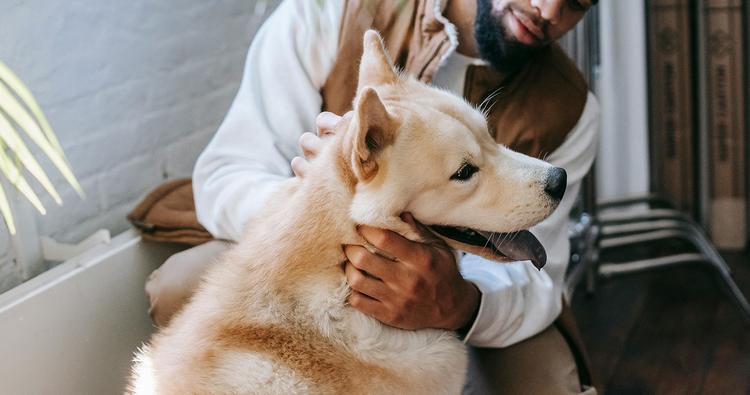by Naomi Strollo, RVT, CPDT-KA, | March 14, 2024

Chalabala / iStock
When you get a new dog or puppy, the last thing you want is for them to be freaked out by your cat. And you really don’t want your cat getting upset and swiping at the dog, either. In an ideal world, both pets would be cool with each other and enjoy their new living situation — but realistically, that’s not always going to happen. Read on to find out why some dogs get scared of cats and the important steps to properly introduce them to each other.
In this article:
Why are dogs afraid of cats?
When you bring home a new dog, they don’t know you, your environment, your routine, or anything about their new life. All those new smells and sounds can be really daunting. And then suddenly, another animal comes out? Yep, talk about stacking triggers.
There are plenty of reasons why a dog might be afraid of cats:
Past experiences with cats that have gone poorly
They have never seen a cat before
They under-socialized with other animals
They had traumatic experiences as a puppy
They are naturally fearful
Whatever the reason, it’s OK. Your new dog is allowed to feel hesitant (or excited) when meeting another pet. Running in fear is a totally normal reaction — better to run than retaliate, which could cause the cat to feel cornered and have to defend themselves.
How do I know if a dog is scared of cats?
Before adoption, you can ask the shelter or rescue questions to see if the dog has ever been around cats before. Even if adopting a puppy, asking their foster parent if there are cats in the home gives you an idea of the dog’s past association with cats. And it could be beneficial to find out if their experience with cats has been with strays, outdoor cats, or cats scared of dogs who might be reactive.
If, after adoption, your pup shows signs of being fearful of cats, such as hiding, cowering, moving away, flattened ears, licking lips, tucked tail, avoiding eye contact, or their hackles raised — there are things you can do the help. Here are the best ways to introduce a fearful dog to a cat.
How to introduce a scared dog to a cat
It’s not often that you can bring a dog inside and have the cat come running up to greet them with open arms. The cat was there first, and it’s their territory. You’re bringing in a new pet that smells different, doesn’t understand personal space, and tries to eat their food and poop. Here are a few steps you can take to make introducing pets easier.
Step 1: Prepare the cat
Once you decide to adopt the dog, it’s time to prepare the cat for the dog’s arrival. Whether an indoor cat or an outdoor/indoor cat, set them up in an area they will be safe. Ideally, this would be a closed room with all their things, aka a “safe room.” This isn’t forever; it’s just temporary.
Get the cat comfortable in this room a few days before the dog arrives. All their toys, litter boxes, and food bowls should be there. If you must carry indoor/outdoor cats to the door, you can, as needed. If the cat is accepting, they can just remain indoors for a few weeks for the initial phase.
Step 2: Prepare your home
Each room should have feline and canine-appealing pheromones diffused through a diffuser. These replicate-appealing pheromones produced by nursing females, which create a sense of belonging to newborn puppies and kittens and help to provide a sense of safety and well-being.
Step 3: Introduce pets by scent
Doing a scent exchange before the dog arrives can be the first introduction. Take items to rub on the dog, like small blankets, towels, and a few cat toys. Return home with these scented items and leave them in the room with the cat. Sit, and watch their reaction. Allow them to come smell you, if they choose to on their own.
Step 4: Meeting behind closed doors
From the moment the dog steps into the house, your cat will know they are there. Keep the dog on a leash as they begin exploring. By sniffing under the door, the cat and dog will both safely exchange greetings through the door. They don’t need to see each other to have a reaction. Allow the sniff, and don’t say anything. Do not touch either one. If they are upset, they can have displaced aggression towards you. You can lure the dog over with food, and drop a trail of treats to get them where you want with the leash.
While the door stays closed, do a scent exchange. This time, rub their toys on the other, and return the toys to them. Leaving for them to sniff and get to know a little more. Do this for three days. During those three days, you can allow the cat out of the room to explore the house when the dog is outside, or on walks. Before the dog returns inside, the cat goes back to the safe area, with the door closed.
Step 5: Create positive associations
You are going to start to get your dog to like your cat with a positive interaction. Bring out the dog’s favorite food. If they love toys more, then bring out the toy. Bring out the cat’s favorite food — try canned food, tuna, sardines, or chicken. If a toy works better, use that instead. Safety is a priority, so put up a baby gate before beginning. And you’ll need two people for this step.
One person starts feeding (or playing with) the dog by the gate. Put some distance from the gate — don’t be right in front of it.
The second person starts feeding (or playing) with the cat. Once they are both involved in eating (or playing), open the door.
If their reaction is positive, they will continue to eat (or play), maybe glance over but go back to their happy activity. Even if they don’t look at the other one, they know they are there. As long as it’s positive, you continue until one is almost out of food. Close the door just before the food runs out.
Continue this pattern of positivity for three days. As long as they have three consecutive days that are positive, you can move a step closer.
If at any point it’s negative, then the calendar day starts at zero again.
When attempting introductions, if your pets react negatively in any way, close the door. If the selection of amazing treats/toys to keep them enthralled isn’t good enough, or they are too close, close the door. You can try a better reward (cheese, hot dog, chicken) and further distance from the baby gate. Continue until you find a starting point of acceptance.
Step 6: Introduction without barrier
If your dog and cat are still not showing signs of fear, now it’s time to let them meet in the same room. Tackle this step multiple times a day, for short interactions, keeping it positive. As long as they are positive, slowly increase the interaction time.
Give your cat an exit route. Keep the door and baby gate up to the area they have been staying in. If they are older and have issues jumping, get a baby gate with little doors at the bottom. You can keep them open so they can run in safely. Bring the cat into the main living area, and keep the dog out. Place the cat in a higher area with their favorite treats.
Bring in your dog, leashed. Feed them high-value treats to keep them calm and make the experience positive. If the dog barks, lunges, or shows any concerning signs, you can use the treats to lure them back outside. If the cat is upset, do not touch them. Allow them to calm down on their own. They are not ready for this step, and you need to go back to feeding with the baby-gate barrier.
Let them investigate. If the dog pulls to investigate out of curiosity, and the cat isn’t afraid, you can allow it. Hold the leash and feed treats. As long as the up-close-and-personal interaction is positive for 30 seconds or less, end it. Use the treat lure to take the dog out, and return the cat to their area.
How to get my scared dog to like my cat
You can get your dog to like your cat by creating a positive association when they see each other. And in order to help create a blissful dog-and-cat living arrangement, humans need to manage it. Help them accept change slowly and positively. Respect their feelings, and have reasonable expectations for the adjustment. We recommend working with a certified professional dog trainer to help you through the process.
References

Naomi Strollo, RVT, CPDT-KA
Naomi Strollo R.V.T, CPDT-KA, has been a Registered Veterinary Technician for over 20 years. Working in general practice and emergency medicine. Having special interest in behavior, she went on to become Fear Free Certified, and a Certified Professional Dog Trainer - Knowledge Assessed (CPDT-KA). She has participated in therapy dog, confirmation, and CGC certifications with her dogs. With positive-reinforcement training, her Akita, Pitbull, and Shiba Inu know how to be friends. Living in Ohio, she enjoys sharing her knowledge through writing contributions.
Related articles

Foster & Volunteer
A Guide to Fostering Cats: How to Become a Foster Parent for Cats

Adoption Advice
How To Puppy Proof Your Home Before Adoption

Adoption Advice
How to Introduce a Cat to a Dog? 6 Essential Steps

Behavior & Training
How Long Does It Take For A Cat To Get Used To A Dog?

Rehome
Rehome My Pet: How to Find a Home For My Pet
If you’re considering finding a new home for a pet, check out Rehome. It’s Adopt a Pet’s safe, simple program that lets people safely rehome a pet.
Behavior & Training
How to Get a Cat to Like a Dog: Tips and Instructions

Behavior & Training
Why Is My Cat Suddenly Chewing On Everything?
Your cat may be suddenly chewing on everything due to anxiety, a medical condition, or even just because he realized it's an activity he enjoys.

Behavior & Training
Is It Okay To Leave A Dog Alone Overnight?

Behavior & Training